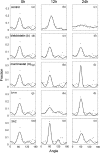Degradation and Remodeling of Epitaxially Grown Collagen Fibrils
- PMID: 31007771
- PMCID: PMC6472930
- DOI: 10.1007/s12195-018-0547-6
Degradation and Remodeling of Epitaxially Grown Collagen Fibrils
Abstract
Introduction—: The extracellular matrix (ECM) in the tumor microenvironment contains high densities of collagen that are highly aligned, resulting in directional migration called contact guidance that facilitates efficient migration out of the tumor. Cancer cells can remodel the ECM through traction force controlled by myosin contractility or proteolytic activity controlled by matrix metalloproteinase (MMP) activity, leading to either enhanced or diminished contact guidance.
Methods—: Recently, we have leveraged the ability of mica to epitaxially grow aligned collagen fibrils in order to assess contact guidance. In this article, we probe the mechanisms of remodeling of aligned collagen fibrils on mica by breast cancer cells.
Results—: We show that cells that contact guide with high fidelity (MDA-MB-231 cells) exert more force on the underlying collagen fibrils than do cells that contact guide with low fidelity (MTLn3 cells). These high traction cells (MDA-MB-231 cells) remodel collagen fibrils over hours, pulling so hard that the collagen fibrils detach from the surface, effectively delaminating the entire contact guidance cue. Myosin or MMP inhibition decreases this effect. Interestingly, blocking MMP appears to increase the alignment of cells on these substrates, potentially allowing the alignment through myosin contractility to be uninhibited. Finally, amplification or dampening of contact guidance with respect to a particular collagen fibril organization is seen under different conditions.
Conclusions—: Both myosin II contractility and MMP activity allow MDA-MB-231 cells to remodel and eventually destroy epitaxially grown aligned collagen fibrils.
Keywords: Directed migration; Function blocking antibody; MMP-14; MT1-MMP; Second harmonic generation.
Conflict of interest statement
CONFLICT OF INTEREST Juan Wang, Anuraag Boddupalli, Joseph Koelbl, Dong Hyun Nam, Xin Ge, Kaitlin M. Bratlie and Ian C. Schneider state they have no conflicts of interest.
Figures






Similar articles
-
Epitaxially grown collagen fibrils reveal diversity in contact guidance behavior among cancer cells.Langmuir. 2015;31(1):307-14. doi: 10.1021/la503254x. Epub 2014 Dec 22. Langmuir. 2015. PMID: 25531276 Free PMC article.
-
Transfer of assembled collagen fibrils to flexible substrates for mechanically tunable contact guidance cues.Integr Biol (Camb). 2018 Nov 12;10(11):705-718. doi: 10.1039/c8ib00127h. Integr Biol (Camb). 2018. PMID: 30320857 Free PMC article.
-
Contact guidance diversity in rotationally aligned collagen matrices.Acta Biomater. 2018 Jan 15;66:248-257. doi: 10.1016/j.actbio.2017.11.039. Epub 2017 Nov 28. Acta Biomater. 2018. PMID: 29196116 Free PMC article.
-
Phagocytosis of collagen by fibroblasts and invasive cancer cells is mediated by MT1-MMP.Biochem Soc Trans. 2007 Aug;35(Pt 4):704-6. doi: 10.1042/BST0350704. Biochem Soc Trans. 2007. PMID: 17635128 Review.
-
MT1-MMP as a Key Regulator of Metastasis.Cells. 2023 Aug 31;12(17):2187. doi: 10.3390/cells12172187. Cells. 2023. PMID: 37681919 Free PMC article. Review.
Cited by
-
Prognostic significance of abnormal matrix collagen remodeling in colorectal cancer based on histologic and bioinformatics analysis.Oncol Rep. 2020 Oct;44(4):1671-1685. doi: 10.3892/or.2020.7729. Epub 2020 Aug 11. Oncol Rep. 2020. PMID: 32945508 Free PMC article.
-
Autophagy-related long non-coding RNAs act as prognostic biomarkers and associate with tumor microenvironment in prostate cancer.Am J Cancer Res. 2024 Feb 15;14(2):545-561. doi: 10.62347/XTDZ5687. eCollection 2024. Am J Cancer Res. 2024. PMID: 38455413 Free PMC article.
-
Aligned Collagen Fibers Drive Distinct Traction Force Signatures to Regulate Contact Guidance.ACS Nano. 2025 Aug 26;19(33):30165-30185. doi: 10.1021/acsnano.5c06736. Epub 2025 Aug 14. ACS Nano. 2025. PMID: 40811686 Free PMC article.
-
Cancer-Associated Fibroblasts Regulate the Plasticity of Breast Cancer Stemness through the Production of Leukemia Inhibitory Factor.Life (Basel). 2021 Nov 26;11(12):1298. doi: 10.3390/life11121298. Life (Basel). 2021. PMID: 34947829 Free PMC article.
-
Matrix Metalloproteinases Shape the Tumor Microenvironment in Cancer Progression.Int J Mol Sci. 2021 Dec 23;23(1):146. doi: 10.3390/ijms23010146. Int J Mol Sci. 2021. PMID: 35008569 Free PMC article. Review.
References
-
- Clark P, Connolly P, Curtis ASG, Dow JAT, Wilkinson CDW. Topographical control of cell behavior. 2. Multiple grooved substrata. Development. 1990;108:635–644. - PubMed
Grants and funding
LinkOut - more resources
Full Text Sources
Miscellaneous

